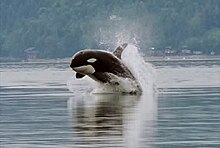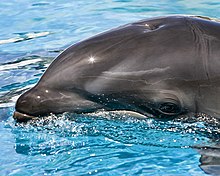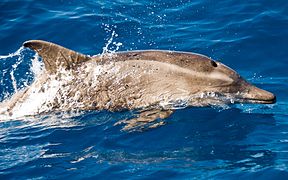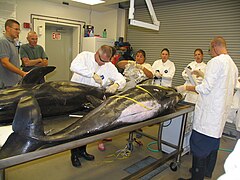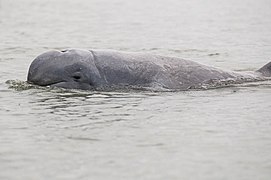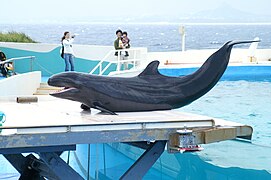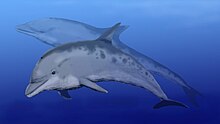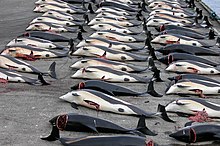Delphinidae
The dolphins (Delphinidae), also called oceanic dolphins to distinguish them from platanistoids or river dolphins, are mammals of a very heterogeneous family of odontocete cetaceans, comprising 37 extant species. They measure between 2 and 8 meters long, with a fusiform body and a large head, an elongated snout and only one spiracle on the top of the head (a respiratory opening that many marine animals have as air or water contact with their internal respiratory system). They are strict carnivores. They are among the most intelligent species that inhabit the planet. They are found relatively close to the coasts and often interact with humans. Like other cetaceans, dolphins use sound, dance, and jumping to communicate, navigate, and reach their prey; They also use echolocation. Today, the main threats to which they are exposed are of an anthropic nature.
Anatomy
Due to evolutionary convergence, its anatomy is very similar to the extinct genus of marine reptiles called Ichthyosaurus.
The species belonging to the Delphinidae family have a fusiform body, adapted to fast swimming. The tail fin, called the caudal, is used for propulsion, while the pectoral fins are used for directional control of swimming. The basic patterns of fur coloration are shades of grey, lighter on the belly and darker ranges on the back. It is often combined with lines and spots of different tints and contrasts.
Like other toothed whales, they have a melon on their head, a spherical organ that they use for echolocation. In several species of the family, the jaws are elongated, forming a distinctive slender snout. They have homodont dentition, with a number of teeth ranging from 20 to 50 in each jaw. They breathe through a single hole at the top of their head, called a blowhole.
Their brain is large, with a fairly developed cerebral cortex compared to the average mammal.
Behavior
Intelligence
Dolphins are often regarded as one of the most intelligent animals on the planet. Comparison of intelligence between different species is complicated due to, among other things, differences in sensory apparatus, response modes, and the nature of cognition. However, dolphin behavior has been extensively studied, both in captivity and in the wild. Oceanic dolphins are known to teach, learn, cooperate, plan, and suffer. The neocortex of many species harbors elongated spindle neurons that, prior to 2007, they were only known in hominids. In humans, these cells are involved in social behavior, emotions, judgment, and theory of mind. Cetacean spindle neurons are found in areas of the brain which are homologous to where they are found in humans, suggesting that they perform a similar function.
Social Conduct
Dolphins are social animals that live in family groups. In places with a great abundance of food, these groups can exceed 1,000 individuals. Dolphins can establish strong social bonds, where even some injured or sick individuals are cared for by others, even helping them to breathe by bringing them to the surface if necessary.. At least in the Tursiops truncatus species, it has been shown that each dolphin has its own name or characteristic whistle, which is used to call it to the herd.
Dolphins show development of culture, something long thought to be unique to humans (and possibly other primate species). In May 2005, Indo-Pacific dolphins were discovered teaching their young to use tools in Australia by covering their snouts with sponges to protect them while feeding. This knowledge is passed on by mothers to their daughters, unlike in primates, where knowledge is generally passed on to both sexes.
Dolphins may also engage in acts of aggression towards other dolphins. An adult male dolphin is very likely to have several bite scars on his body. Male dolphins engage in such acts of aggression, due to mate conflicts and competition for females.
Playback
Dolphins mate in front of each other. The actual act is usually brief, but can be repeated several times in a short span. Some use a very gallant technique in which the males "sing" love verses in order to win over the female.
The gestation period varies among species. The small tucuxi has a gestation period of 11 to 12 months, while for the orca the gestation period is around 17 months. They only have one baby. In general, sexual activity begins at an early age, even before reaching sexual maturity, many studies affirm that these animals are one of the few that mate for pleasure and not just for a reproductive instinct. The age of sexual maturity Varies by species and genus.
Food
There are various feeding methods between and within species belonging to the Delphinidae family. During the first months of life it feeds on mother's milk because it is a mammal. It subsequently feeds on fish and squid as its main food, but the false killer whale and killer whale also feed on other marine mammals. Dolphins use a wide variety of hunting tactics: they often hunt using their speed, but they also use echolocation to search for prey buried in the sand. Dolphins that hunt fish, grouped in schools, form pods and corral them to separate them from the rest of the group. Other dolphins corner their prey on the shoreline of a beach and then take advantage of the waves to capture it, although this is a risky tactic. Killer whales and false killer whales have many other hunting tactics, due to the wide range of prey they consume. Apart from the tactics already mentioned, they also stalk their prey or hit ice ledges to throw them off balance.
Vocalizations
Dolphins are capable of making a wide range of sounds using nasal air sacs located just below the blowhole. There are three categories of sounds:
- Modulated frequency silts.
- Sound impulse bursts.
- Clicks (used for Ecolocalization).
This ability is called echolocation. The military forces of some countries use dolphins and this ability to help them find underwater targets. Some scientists have speculated that dolphins also use sounds to send acoustic shocks to kill small prey.
Echolocation
Echolocation involves the emission by dolphins of a wide range of sounds in the form of short bursts of sound impulses called clicks and obtaining information about the environment by analyzing the echoes they get back. This ability to use a full range of both high and low frequency sound emissions, combined with highly sensitive directional hearing, facilitates extremely accurate echolocation and gives these animals a unique sensory system in the sea.
Taxonomy
Family Delphinidae
| Gender | Species (binominal) | Vernacular name |
| Australodelphis † | Australodelphis mirus † | (Delfin of the Antarctic Pliocene) |
| Cephalorhynchus | Cephalorhynchus commersonii | Tonina overa |
| Cephalorhynchus eutropia | Tonina Chilean | |
| Cephalorhynchus heavisidii | Dolphin of Heaviside | |
| Cephalorhynchus hectori | Dolphin of Hector | |
| Delphinus | Delphinus capensis | Common seaside dolphin |
| Delphinus delphis | Oceanic common dolphin | |
| Eodelphinus † | Eodelphinus kabatensis † | (Japanese Upper Miocene Delfin) |
| Feresa | Feresa attenuata | Pygmy Orca |
| Globicephala | Globicephala macrorhynchus | Calderon of short fin |
| Globicephala melas | Common Calderon | |
| Grampus | Grampus griseus | Dolphin of Risso |
| Lagenodelphis | Lagenodelphis hosei | Dolphin of Fraser |
| Lagenorhynchus | Lagenorhynchus acutus | Dolphin of the Atlantic |
| Lagenorhynchus albirostris | White snout dolphin | |
| Lagenorhynchus australis | Southern or Antarctic dolphin | |
| Lagenorhynchus cruciger | Cross dolphin | |
| Lagenorhynchus obliquidens | Pacific Dolphin of White Sides | |
| Lagenorhynchus obscurus | Dark dolphin or Fitzroy | |
| Lissodelphis | Lissodelphis borealis | Northern dolphin without fin |
| Lissodelphis peronii | Southern dolphin without fin | |
| Orcaella | Orcaella brevirostris | Dolphin beluga of the Irrawaddy River |
| Orcaella heinsohni | Dolphin Beluga of Heinsohn | |
| Orcinus | Orcinus orca | Common Orca |
| Peponocephala | Peponocephala electra | Melon-headed dolphin |
| Plataleastrum † | Platalearostrum hoekmani † | (North Sea Plio-Pleistocene) |
| Protoglobicephala † | Protoglobicephala mexican † | (Delfin of the California Gulf Pliocene) |
| Pseudorca | Pseudorca crassidens | False orca |
| Sotalia | Sotalia fluviatilis | Tucuxi |
| Sotalia guianensis | Coastal dolphin | |
| Sousa | Sousa chinensis | Hong Kong Pink Dolphin |
| Sousa teuszii | Atlantic gloom | |
| Stenella | Stenella attenuata | Dolphin or tropical stained |
| Stenella clymene | Dolphin short snout acrobat | |
| Stenella coeruleoalba | Dolphin listed | |
| Stenella frontalis | Dolphin stained from the Atlantic | |
| Stenella longirostris | Dolphin long snout acrobat | |
| Steno | Steno bredanensis | Strict snout dolphin |
| Tursiops | Tursiops aduncus | Indo-Pacific Dolphin |
| Tursiops australis | Delfín burrunan | |
| Tursiops truncatus | Dolphin bottle or mular nose |
- Several species of dolphins
Hybridization
Hybridization is the mating between a male and a female of two different species, belonging to the same genus or at least the same family. In the case of the Delphinidae family, the so-called balfins occur. There are few records in a controlled environment, not existing in free life. The records refer to the crossing of a female bottlenose dolphin and a male false killer whale, obtained in a water park in the Hawaiian Islands.
Evolution
Dolphins, along with all other cetaceans, were long thought to be descendants of the mesonychians, an extinct order of wolf-like ungulates. However, genetic studies have shown that cetaceans (including dolphins) are actually more closely related to artiodactyls, from which they diverged about 60 million years ago; the closest artiodactyls would be hippopotamuses. It is estimated that during the Eocene (around fifty million years ago), the ancestors of cetaceans took refuge in the water, similar to modern swallowlids.
Fossil evidence shows that toothed cetes appeared in the Miocene. The earliest known dolphins belong to the family Kentriodontidae. These primitive dolphins already possessed a developed sense of echolocation and the melon organ. The skeletons of modern dolphins have two small bones in the sacral area of the vertebral column, which correspond to vestiges of the pelvis.
Threats
Natural threats
Except for humans in general, dolphins have few natural enemies. The largest species of dolphins do not have predators. For the smaller species, only the killer whale (Orcinus orca), and a few shark species such as the bull shark, tiger shark, or great white shark are a potential risk, especially for pups.
Human threats
Environmental pollution of oceans, seas and rivers is a concern. Pesticides, heavy metals, plastics, and other industrial and agricultural pollutants that do not break down quickly in the environment can cause the reduction of dolphin populations, and cause tissue accumulation of high levels of pollutants. Injuries or deaths caused by collisions with boats, especially their propellers, are also common. Various net fishing methods cause the death of trapped dolphins, especially in tuna purse seine fishing.
On the other hand, in some parts of the world dolphins are part of the traditional diet, such as in Taiji (in Japan) or the Faroe Islands.
Relationship with the human being
Dolphins have always had a close relationship with man. Apart from the threats that dolphins suffer from man, they are used in shows and in the army. In addition, dolphins have given rise to various legends in numerous cultures.
Dolphins in legends and mythology
The appearances of dolphins in mythology and legends are numerous, and attest to the relationship between man and dolphins since ancient times. Greek mythology tells that these marine mammals were men before dolphins, specifically some pirates who tried to sell the god Dionysus as a slave and, as punishment, he turned them into said cetaceans, and in the same civilization the god Poseidon who ruled over the water and the sea, was always represented with his characteristic trident and surrounded by dolphins. According to another legend, Poseidon convinced Amphitrite to marry him by sending her a dolphin.
In the Chilota mythology of Chile, it is said that there is a mythological being known as Cahuelche, who was originally a human being who was magically turned into a marine creature with an appearance very similar or identical to the species of dolphin called tonina. However, the Cahuelche would be much more intelligent than the animals of this species and the sound it would emit would be different from that of these dolphins; and would have a meaning that is magically understandable to humans.
Dolphins as a show
Today, many dolphins (particularly bottlenose dolphins and orcas) are trained to participate in educational displays in zoos and water parks. Taking advantage of their intelligence and abilities, these dolphins are trained to perform behaviors according to signs by their keepers during intensive training, always reinforced with a positive stimulus, such as play or food. Exercises performed by a trained dolphin include jumping, pirouettes in the air, movements on land platforms, and movements with the tail flicking backwards. Many of these activities are the same behaviors that animals perform in the wild.
Dolphins in the army
The intelligence of the dolphins is also used by the army with the so-called military dolphins. In the United States there is a Navy Marine Mammal Program (NMMP) in which they train to detect mines, protect army installations, and attack enemy forces. This program has existed since the 1960s, and it trains, among other mammals, killer whales, false killer whales, bottlenose, common, narrow-snouted and Risso's dolphins, and pilot whales.
Cooperative fishing
References to cooperative fishing between humans and dolphins can be found in studies by the Roman naturalist philosopher Pliny the Elder. A similar association can be observed today in the city of Laguna, in the state of Santa Catarina, Brazil. There the fishermen form a line of men and/or canoes parallel to the coast, waiting for the dolphins to appear. Fishing only begins when one or more bottlenose dolphins (Tursiops truncatus) chase the fish towards the men. At a precise moment, the dolphins give a signal for the fishermen to throw their nets. This signal is observed only during cooperative fishing and implies the fleeting appearance of the dolphin on the surface of the water for about 1.4 seconds, accompanied by a brief exhalation of air. Both dolphins and men benefit from this cooperation.
Contenido relacionado
Artificial life
Equisetidae
Linaceae

